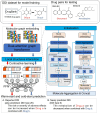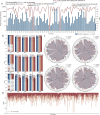DrugDAGT: a dual-attention graph transformer with contrastive learning improves drug-drug interaction prediction
- PMID: 39396972
- PMCID: PMC11472440
- DOI: 10.1186/s12915-024-02030-9
DrugDAGT: a dual-attention graph transformer with contrastive learning improves drug-drug interaction prediction
Abstract
Background: Drug-drug interactions (DDIs) can result in unexpected pharmacological outcomes, including adverse drug events, which are crucial for drug discovery. Graph neural networks have substantially advanced our ability to model molecular representations; however, the precise identification of key local structures and the capture of long-distance structural correlations for better DDI prediction and interpretation remain significant challenges.
Results: Here, we present DrugDAGT, a dual-attention graph transformer framework with contrastive learning for predicting multiple DDI types. The dual-attention graph transformer incorporates attention mechanisms at both the bond and atomic levels, thereby enabling the integration of short and long-range dependencies within drug molecules to pinpoint key local structures essential for DDI discovery. Moreover, DrugDAGT further implements graph contrastive learning to maximize the similarity of representations across different views for better discrimination of molecular structures. Experiments in both warm-start and cold-start scenarios demonstrate that DrugDAGT outperforms state-of-the-art baseline models, achieving superior overall performance. Furthermore, visualization of the learned representations of drug pairs and the attention map provides interpretable insights instead of black-box results.
Conclusions: DrugDAGT provides an effective tool for accurately predicting multiple DDI types by identifying key local chemical structures, offering valuable insights for prescribing medications, and guiding drug development. All data and code of our DrugDAGT can be found at https://github.com/codejiajia/DrugDAGT .
Keywords: Attention; Drug-drug interactions; Graph transformer; Interpretation.
© 2024. The Author(s).
Conflict of interest statement
The authors declare no competing interests.
Figures





Similar articles
-
Taco-DDI: accurate prediction of drug-drug interaction events using graph transformer-based architecture and dynamic co-attention matrices.Neural Netw. 2025 Sep;189:107655. doi: 10.1016/j.neunet.2025.107655. Epub 2025 May 20. Neural Netw. 2025. PMID: 40446573
-
MPHGCL-DDI: Meta-Path-Based Heterogeneous Graph Contrastive Learning for Drug-Drug Interaction Prediction.Molecules. 2024 May 24;29(11):2483. doi: 10.3390/molecules29112483. Molecules. 2024. PMID: 38893359 Free PMC article.
-
HLN-DDI: hierarchical molecular representation learning with co-attention mechanism for drug-drug interaction prediction.BMC Bioinformatics. 2025 Jun 4;26(1):152. doi: 10.1186/s12859-025-06157-6. BMC Bioinformatics. 2025. PMID: 40468206 Free PMC article.
-
A comprehensive review of deep learning-based approaches for drug-drug interaction prediction.Brief Funct Genomics. 2025 Jan 15;24:elae052. doi: 10.1093/bfgp/elae052. Brief Funct Genomics. 2025. PMID: 39987494 Free PMC article. Review.
-
ABIET: An explainable transformer for identifying functional groups in biological active molecules.Comput Biol Med. 2025 Mar;187:109740. doi: 10.1016/j.compbiomed.2025.109740. Epub 2025 Feb 1. Comput Biol Med. 2025. PMID: 39894011 Review.
Cited by
-
Multimodal fusion with relational learning for molecular property prediction.Commun Chem. 2025 Jul 5;8(1):200. doi: 10.1038/s42004-025-01586-z. Commun Chem. 2025. PMID: 40617967 Free PMC article.
-
Geometry-enhanced graph neural networks accelerate circRNA therapeutic target discovery.Front Genet. 2025 Jul 7;16:1633391. doi: 10.3389/fgene.2025.1633391. eCollection 2025. Front Genet. 2025. PMID: 40692709 Free PMC article.
-
Artificial Intelligence Models and Tools for the Assessment of Drug-Herb Interactions.Pharmaceuticals (Basel). 2025 Feb 20;18(3):282. doi: 10.3390/ph18030282. Pharmaceuticals (Basel). 2025. PMID: 40143062 Free PMC article. Review.
-
SCATrans: semantic cross-attention transformer for drug-drug interaction predication through multimodal biomedical data.BMC Bioinformatics. 2025 Jun 10;26(1):157. doi: 10.1186/s12859-025-06165-6. BMC Bioinformatics. 2025. PMID: 40495152 Free PMC article.
-
Leveraging Network Target Theory for Efficient Prediction of Drug-Disease Interactions: A Transfer Learning Approach.Adv Sci (Weinh). 2025 Mar;12(11):e2409130. doi: 10.1002/advs.202409130. Epub 2025 Jan 28. Adv Sci (Weinh). 2025. PMID: 39874191 Free PMC article.
References
-
- Edwards IR, Aronson JK. Adverse drug reactions: definitions, diagnosis, and management. Lancet. 2000;356(9237):1255–9. - PubMed
-
- Sun X, Vilar S, Tatonetti NP. High-throughput methods for combinatorial drug discovery. Scienc Translational Medicine. 2013;5(205):205rv1-205rv1. - PubMed
-
- Whitebread S, Hamon J, Bojanic D, Urban L. Keynote review: In vitro safety pharmacology profiling: an essential tool for successful drug development. Drug Discovery Today. 2005;10(21):1421–33. - PubMed
-
- Yang Y, Gao D, Xie X, Qin J, Li J, Lin H, et al. DeepIDC: a prediction framework of injectable drug combination based on heterogeneous information and deep learning. Clin Pharmacokinet. 2022;61(12):1749–59. - PubMed
MeSH terms
LinkOut - more resources
Full Text Sources
Medical

